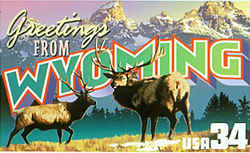


Wyoming Early History
First Early Inhabitants of Wyoming

Early history examines the archaeological record that tells the story of the first inhabitants of Wyoming. Learn about the prehistory and culture of the first early inhabitants, and what lessons it might teach us about the early history of Wyoming.
Wyoming First Early Inhabitants Timeline
- 150Mil BC - 145Mil BC Most of the dinosaur fossils at Thermopolis, Wyo., were from this period. The area had a humid, tropical climate with many streams. Diplodocus, Monolophosaurus, and Camarasaur, a 60-foot-tall plant-eater, were some of the creatures found. (SFEC, 4/27/97, p.T1,5)
- 80Mil BC - Upper Cretaceous Lance Formation in Montana, Wyoming and S. Dakota has fossils of Pachycephalosaurus (thick-headed lizards). They stood on two feet and were herbivorous. They had a dome-like development on the skull made of solid bone, most likely used in combat as a battering ram. It stood 5m and had spikes on its nose and around the back of its skull. (TE-JB, p.91)(Econ, 10/27/12, p.81)
- c65 Million - In 1998 fossilized fragments of a tiny shrew-like mammal, Batodonoides, were reported from north-central Wyoming. It weighed as little as 1.3 grams. (SFC, 10/1/98, p.A2)
- 55Mil BC - An increase in temperature prompted a major shift in plant distribution. In 2005 scientist reported that Earth warmed 9 to 18 degrees over a 10,000 years to a warm period that lasted 80-120 thousand years. Plants in the southern US spread 1,000 miles from the gulf Coast to Wyoming, and disappeared when the climate cooled off. (SFC, 11/11/05, p.A7)
- 55Mil BC - Alligators and palm trees inhabited Wyoming during the Palaeocene-Eocene Thermal Maximum (PETM). (Econ, 2/25/06, p.82)
- 52Mil BC - In 2008 the fossil of a bat from this time indicated that it could fly but not navigate through echolocation. It was found in Wyoming and scientists named it Onychonycteridae finneyi, meaning clawed bat due to claws on all five fingers. (SFC, 2/14/08, p.A2)
- 52Mil BC - Fossil Lake in south-west Wyoming dated to about this time. It later become known for its millions of fossils preserved in layers of limestone and volcanic ash. In 2009 scientists believed that repeated die outs in the lake were caused by neurotoxins created by dinoflagellates. (Econ, 10/3/09, p.99)
- 50Mil BC - The Fossil Butte Member of the Green River Formation in southwest Wyoming represents the sedimentary remains of an ancient lake community that dates to this time. Crocodiles inhabited Wyoming. (NH, 7/98, p.66)(Econ, 9/9/06, p.11)
- 640000 BC - Volcanic eruptions in northwest Wyoming, extending to Idaho and Montana, created a caldera some 40 miles long and 30 miles wide. The surface collapsed thousands of feet into a magma pool and marked the area later known as Yellowstone. Continuing eruptions caused climactic changes around the world. (SFEC, 10/18/98, p.T5)(HC, 10/10/06)
- c6000BC - Remains of a probable human structure in Hells Gap were dated to this time. (SFC, 9/19/97, p.A3)
- 1000 AD - Woodland period with permanent houses and farming
1742 - Francois and Louis Verendrye are the first white men to sight Wyoming
1775 - 1783 - The American Revolution.
1778 - Wyoming Valley Massacre - Iroquois allies of the Loyalist forces massacre white colonists
Early History of Native Americans in Wyoming
The Indigenous People of Wyoming
The names of the Wyoming tribes included the Arapaho, Bannock, Cheyenne, Comanche, Crow, Dakota Sioux, Kiowa, Pawnee, Shoshone and the Ute.
People were living in the area we now call Wyoming more than 12,000 years ago. These people were probably part of the Clovis culture. In the next
two to four thousand years, there is evidence of other cultures living and moving through this area including people who hunted big game, including
animals that no longer exist, like the wooly mammoth.
One site that offers us more questions than answers about the early inhabitants of Wyoming is the Medicine Wheel, near Lovell. The Wheel, actually
an arrangement of white stones forming a 70-foot diameter wheel with spokes, has been dated by archaeologists as being about 7,000 years old. Scientists
believe it may have been built as an astronomical observatory, or to mark the equinox, but no one knows for sure who built it or why. However, the
Crow Indians, as well as other Plains Indian tribes, believe the wheel is a sacred religious site that was constructed by their ancestors "before the
light came, by people who had no iron." Today, the site is being studied, but steps have been taken to respect the Native Americans' access to the
site for religious rituals.
Another prehistoric site that shows evidence of Wyoming's earliest residents is the remains of stone quarries near the town of Lusk. These quarries,
called the "Spanish Diggings"show how people mined quartzite, jasper and agate for use in making tools. We know people made and traded these items,
because artifacts made of Wyoming minerals have been found as far away as the Ohio and Mississippi River Valleys.
The area that would become Wyoming was inhabited by several Native American groups before the arrival of Europeans. The Shoshone, Arapaho, Cheyenne
and Crow lived in the eastern portion of the area. They hunted bison, following the tremendous herds through their seasonal migrations, and lived in
tepees. The Ute people inhabited Wyoming's western mountains, depending less on bison and more on the gathering of wild foods, the hunting of smaller
game (antelope, rabbit, deer, elk) and fishing. One Indian reservation remains in Wyoming today. It is home to over 5,000 Shoshone and Arapaho Indians.





